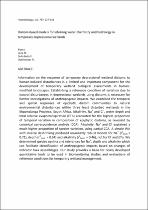 ResearchSpace
ResearchSpace
Diatom-based models for inferring water chemistry and hydrology in temporary depressional wetlands
JavaScript is disabled for your browser. Some features of this site may not work without it.
- ResearchSpace
- →
- Research Publications/Outputs
- →
- Journal Articles
- →
- View Item
| dc.contributor.author |
Riato, L

|
|
| dc.contributor.author |
Leira, M

|
|
| dc.contributor.author |
Della Bella, V

|
|
| dc.contributor.author |
Oberholster, Paul J

|
|
| dc.date.accessioned | 2017-11-06T12:48:49Z | |
| dc.date.available | 2017-11-06T12:48:49Z | |
| dc.date.issued | 2017-08 | |
| dc.identifier.citation | Riato, L. et al. 2017. Diatom-based models for inferring water chemistry and hydrology in temporary depressional wetlands. Hydrobiologia, vol. 797: 127-143 | en_US |
| dc.identifier.issn | 0018-8158 | |
| dc.identifier.uri | DOI 10.1007/s10750-017-3165-8 | |
| dc.identifier.uri | https://link.springer.com/article/10.1007/s10750-017-3165-8 | |
| dc.identifier.uri | http://hdl.handle.net/10204/9719 | |
| dc.description | Copyright: 2017 Springer. Due to copyright restrictions, the attached PDF file only contains the abstract of the full text item. For access to the full text item, kindly consult the publisher's website. | en_US |
| dc.description.abstract | Information on the response of temporary depressional wetland diatoms to human-induced disturbances is a limited and important component for the development of temporary wetland biological assessments in human-modified landscapes. Establishing a reference condition of variation due to natural disturbances in depressional wetlands using diatoms is necessary for further investigations of anthropogenic impacts. We examined the temporal and spatial responses of epiphytic diatom communities to natural environmental disturbances within three least disturbed wetlands in the Mpumalanga Province, South Africa. Alkalinity, Na(sup+) and Cl(sup-), water depth and total relative evapotranspiration (ETo) accounted for the highest proportion of temporal variation in composition of epiphytic diatoms, as revealed by canonical correspondence analysis (CCA). Alkalinity, Na(sup+), and Cl(sup)- explained a much higher proportion of species variation, using partial CCA. A simple WA with inverse deshrinking produced reasonably robust models for Na(sup+) (rboot(sup2) = 0.71), depth (rboot(sup2) = 0.64) and alkalinity (rboot(sup2) = 0.46), not for Cl(sup-) and ETo. We determined species optima and tolerances for Na+, depth and alkalinity which can facilitate identification of anthropogenic impacts based on changes of indicator taxa assemblag(supe)s. Our study provides a basis for newly developed quantitative tools to be used in biomonitoring studies and evaluations of reference conditions for temporary wetland management. | en_US |
| dc.language.iso | en | en_US |
| dc.publisher | Springer | en_US |
| dc.relation.ispartofseries | Worklist;19756 | |
| dc.relation.ispartofseries | Worklist;19757 | |
| dc.subject | Alkalinity | en_US |
| dc.subject | Ionic composition | en_US |
| dc.subject | Weighted averaging | en_US |
| dc.subject | Optima | en_US |
| dc.subject | Temporal variability | en_US |
| dc.subject | Tolerances | en_US |
| dc.title | Diatom-based models for inferring water chemistry and hydrology in temporary depressional wetlands | en_US |
| dc.type | Article | en_US |
| dc.identifier.apacitation | Riato, L., Leira, M., Della Bella, V., & Oberholster, P. J. (2017). Diatom-based models for inferring water chemistry and hydrology in temporary depressional wetlands. http://hdl.handle.net/10204/9719 | en_ZA |
| dc.identifier.chicagocitation | Riato, L, M Leira, V Della Bella, and Paul J Oberholster "Diatom-based models for inferring water chemistry and hydrology in temporary depressional wetlands." (2017) http://hdl.handle.net/10204/9719 | en_ZA |
| dc.identifier.vancouvercitation | Riato L, Leira M, Della Bella V, Oberholster PJ. Diatom-based models for inferring water chemistry and hydrology in temporary depressional wetlands. 2017; http://hdl.handle.net/10204/9719. | en_ZA |
| dc.identifier.ris | TY - Article AU - Riato, L AU - Leira, M AU - Della Bella, V AU - Oberholster, Paul J AB - Information on the response of temporary depressional wetland diatoms to human-induced disturbances is a limited and important component for the development of temporary wetland biological assessments in human-modified landscapes. Establishing a reference condition of variation due to natural disturbances in depressional wetlands using diatoms is necessary for further investigations of anthropogenic impacts. We examined the temporal and spatial responses of epiphytic diatom communities to natural environmental disturbances within three least disturbed wetlands in the Mpumalanga Province, South Africa. Alkalinity, Na(sup+) and Cl(sup-), water depth and total relative evapotranspiration (ETo) accounted for the highest proportion of temporal variation in composition of epiphytic diatoms, as revealed by canonical correspondence analysis (CCA). Alkalinity, Na(sup+), and Cl(sup)- explained a much higher proportion of species variation, using partial CCA. A simple WA with inverse deshrinking produced reasonably robust models for Na(sup+) (rboot(sup2) = 0.71), depth (rboot(sup2) = 0.64) and alkalinity (rboot(sup2) = 0.46), not for Cl(sup-) and ETo. We determined species optima and tolerances for Na+, depth and alkalinity which can facilitate identification of anthropogenic impacts based on changes of indicator taxa assemblag(supe)s. Our study provides a basis for newly developed quantitative tools to be used in biomonitoring studies and evaluations of reference conditions for temporary wetland management. DA - 2017-08 DB - ResearchSpace DP - CSIR KW - Alkalinity KW - Ionic composition KW - Weighted averaging KW - Optima KW - Temporal variability KW - Tolerances LK - https://researchspace.csir.co.za PY - 2017 SM - 0018-8158 T1 - Diatom-based models for inferring water chemistry and hydrology in temporary depressional wetlands TI - Diatom-based models for inferring water chemistry and hydrology in temporary depressional wetlands UR - http://hdl.handle.net/10204/9719 ER - | en_ZA |





